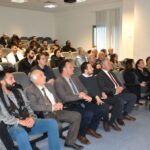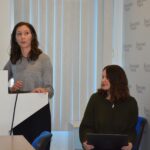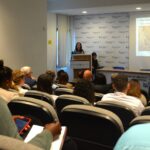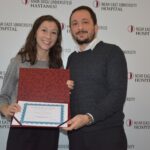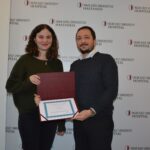
In the symposium held at Near East University, engineers working at Simpson Gumpertz & Heger, one of the leading engineering firms in the United States, discussed marine structures.
The “Marine Engineering: From Routine to Crisis” symposium, carried out in collaboration with Near East University Faculty of Civil and Environmental Engineering and Near East University Technology Transfer Office (NERITA), brought together experts in the field. Current developments in coastal and port engineering were discussed at the symposium.
In the symposium, which attracted a large number of participants, Senior Engineer Allison C. DiGregorio and Dolunay Öniz, who work for “Simpson Gumpertz & Heger,” one of the leading engineering firms in the United States in the fields of engineering, design and construction, provided information to the participants with their presentations. The symposium, which was held in two sessions, was moderated by Near East University Technology Transfer Office President Prof. Dr. Murat Özgören.
In the first session of the symposium, Allison C. DiGregorio addressed the topic of “Coastal Structure Engineering Evaluations”, in the second session Dolunay Öniz shared “Field observations on marine structures in southeastern Turkey affected by the earthquakes in February 2023”. At the end of the symposium, which ended with a question and answer session, Near East University Vice Rector Prof. Dr. Umut Aksoy presented certificates of appreciation to Allison C. DiGregorio and Dolunay Öniz.
Climate change impact on the design of marine structures!
Addressing the factors to be considered in the design of basic structures in the field of marine engineering, Senior Engineer Allison C. DiGregorio spoke on the engineering techniques used in a wide range from piers to docks, from breakwaters to dry docks. Stating that one of the biggest challenges of marine engineering is rising sea levels, coastal development and the reconstruction of old industrial areas, DiGregorio said, “Marine structures must cope with various engineering challenges, not only waves and currents, but also seismic risks and soils contaminated with industrial waste.” She emphasized the importance of deep soil mixture (DSM), anchor systems and piled quay designs to increase the durability of coastal structures, especially in regions with high earthquake risk. DiGregorio shared the details of the ground reinforcement works carried out by giving examples from around the world. DiGregorio said, “While a 75-year service life is targeted in the design of marine structures, considering factors such as climate change and sea level rise has become a critical requirement.” and drew attention to the importance of sustainable and long-term solutions. DiGregorio stated that marine structures are of great importance not only in terms of engineering, but also in terms of society and economy.
Soil liquefaction is a big risk!
Senior Engineer Dolunay Öniz shared the field observations she made on the southeastern sea structures affected by the earthquakes in Turkey in February 2023, and in her presentation shared the results of the examinations she conducted in the region with her team, and evaluated the performance of the ports, piers and filling areas in İskenderun and its surroundings against earthquakes. Öniz, who stated that especially the piled structures remained generally durable, drew attention to the damages suffered by the coastal structures by saying, “Soil liquefaction, settlements and horizontal deformations were widely observed.” Öniz stated that the ports assumed a critical role in terms of logistics after the earthquake, and said, “Ports were of great importance in terms of delivering emergency aid supplies and providing shelter support.” Öniz also emphasized that the rapid repair processes in the region were supported by the advantages of having construction equipment and materials on site.
